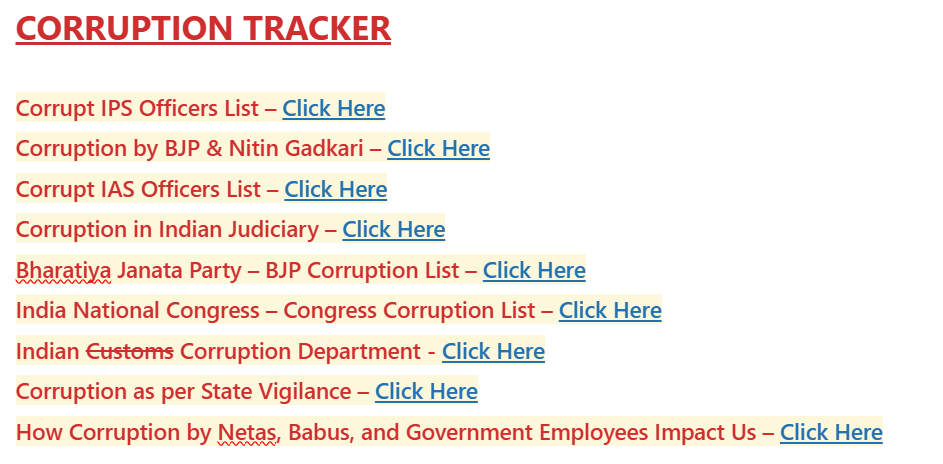CORRUPTION TRACKER
Corrupt IPS Officers List – Click Here
Corruption by BJP & Nitin Gadkari – Click Here
Corrupt IAS Officers List – Click Here
Corruption in Indian Judiciary – Click Here
Bharatiya Janata Party – BJP Corruption List – Click Here
India National Congress – Congress Corruption List – Click Here
Indian Customs Corruption Department – Click Here
GST Corruption – Goods & Service TAX = Corruption – Click Here
Corruption as per State Vigilance – Click Here
How Corruption by Netas, Babus, and Government Employees Impact Us – Click Here
Corruption is a deep-rooted issue in India, cutting across various sectors of governance, and adversely affecting development, public trust, and socio-economic progress. In states like Odisha, the situation is even more dire due to widespread corruption across various administrative levels, especially involving political leaders (Netas), bureaucrats (Babus), and government employees. This article will dive into the consequences of corruption, its impact on public welfare, and how it is hindering the progress of not just Odisha but India as a whole.
The Nexus of Corruption
Political Corruption (Netas)
Politicians, colloquially known as Netas, play a significant role in steering the direction of policies, laws, and governance. However, many are involved in corrupt practices, ranging from bribery, illegal land acquisitions, to embezzlement of public funds meant for welfare schemes. Odisha has witnessed several scandals where politicians have been accused of amassing wealth through corrupt means, neglecting the needs of the common man. Political corruption tends to promote nepotism and patronage, and many politicians engage in selling their influence for personal gain rather than working for the welfare of the people.
Key issues include:
• Public Fund Misappropriation: Public funds intended for essential services such as education, healthcare, and infrastructure are diverted for personal or political gains. The PDS (Public Distribution System) scam in Odisha, where food grains meant for the poor were siphoned off by politicians and bureaucrats, exemplifies this.
• Delays in Projects: Development projects, such as infrastructure development and housing for the poor, face long delays or poor execution because contractors have to pay bribes to politicians and bureaucrats to get the projects cleared, resulting in subpar quality of public infrastructure.
Bureaucratic Corruption (Babus)
Bureaucrats, often referred to as Babus, occupy powerful positions within the state machinery, handling the daily administration and decision-making processes. Unfortunately, this bureaucratic class is not free from corruption. Corrupt officials abuse their positions by accepting bribes, manipulating records, and misusing their authority.
For example, delays in issuing permits for industries, businesses, and even small-scale enterprises often occur unless bribes are paid. This not only stifles economic growth but also discourages entrepreneurs and businesses from investing in the state. In Odisha, widespread corruption among senior bureaucrats has stalled development projects and welfare programs, especially in rural areas.
Specific cases of bureaucratic corruption in Odisha include:
• Mining Scams: Illegal mining in Odisha has been rampant, with Babus colluding with local and national companies to allow unlawful mining operations, resulting in the loss of thousands of crores in revenue to the state exchequer. This illegal activity has led to environmental degradation and the displacement of indigenous communities.
• Healthcare Corruption: Corruption in the public healthcare system is particularly harmful. Medical supplies, hospital equipment, and other resources are often sold in the black market, leaving public hospitals ill-equipped. This has been a particular problem in Odisha, where rural healthcare is woefully inadequate.
Corruption among Government Employees
Corruption among lower and middle-level government employees is pervasive in both urban and rural parts of Odisha. Common citizens have to pay speed money for basic services, such as obtaining a driving license, land registry, or even pensions. Government employees often exploit the complexity of administrative procedures to extract bribes from the public.
• Leakage in Welfare Schemes: Welfare schemes such as MGNREGA (Mahatma Gandhi National Rural Employment Guarantee Act) are plagued by leakages where fake beneficiaries are added to muster rolls, and wages meant for the poor are siphoned off by corrupt officials.
• Police Corruption: In Odisha, corruption within the law enforcement system undermines public trust. Police often accept bribes to ignore crimes, or to manipulate investigations, and citizens must pay to get their grievances heard. This creates an environment where the powerful and wealthy can escape justice, while the poor and marginalized suffer.

Impacts of Corruption on Odisha’s Development
1. Stunted Economic Growth:
Corruption is a major hindrance to the economic progress of Odisha. The state’s abundant natural resources—coal, bauxite, iron ore—should ideally lead to significant industrial development. However, corruption in mining and infrastructure has stalled growth, as illegal mining operations and bribes for contract allocations leave state coffers dry.
Furthermore, foreign direct investment (FDI), which is crucial for industrialization and infrastructure development, is often discouraged by the lack of transparency in governance. Investors are reluctant to navigate a system where bribes and delays are common.
2. Social Inequality:
Corruption disproportionately affects the poor, particularly in tribal regions of Odisha where access to education, healthcare, and welfare schemes is limited. Ration card scams, land grabbing, and manipulation of welfare schemes have kept the poorest sections of society in a state of deprivation. Corrupt officials take advantage of the low literacy rates and lack of awareness among rural populations to siphon off benefits meant for them.
3. Environmental Degradation:
Corruption has had a direct and severe impact on the environment in Odisha. Illegal mining operations, facilitated by corrupt officials, have led to deforestation, soil erosion, and the destruction of biodiversity. The Niyamgiri Hills controversy, where a mining project threatened the livelihood of the Dongria Kondh tribe, is an example of how corruption has allowed large-scale environmental destruction to proceed unchecked.
4. Weak Infrastructure:
Corruption in the construction sector results in poor-quality public infrastructure. Roads, bridges, and public buildings are often constructed using substandard materials as a result of kickbacks paid to officials. This not only wastes public money but also compromises public safety.
Corruption and India’s National Progress
The problem of corruption is not limited to Odisha but extends across the entire country. Transparency International ranked India 85th out of 180 countries in its Corruption Perception Index (CPI) in 2022. Despite economic growth, corruption continues to act as a major barrier to equitable development.
National Consequences of Corruption:
1. Erosion of Public Trust:
Corruption erodes trust in public institutions, including the judiciary, law enforcement, and public service providers. When the public perceives that the system is rigged in favor of the powerful, confidence in democratic processes diminishes.
2. Investment Deterrence:
Both domestic and foreign investors are wary of investing in sectors that are riddled with bureaucratic red tape and corruption. According to World Bank estimates, corruption in India raises business costs by at least 20-25%. This hinders both local startups and multinational corporations from investing in key sectors.
3. Undermining Social Programs:
Corruption in social welfare programs like Mid-Day Meal Scheme, Public Distribution System, and Rural Employment Guarantee Schemes leads to millions of Indians being deprived of essential services, food, and employment opportunities.
Combatting Corruption: Steps Forward
Odisha and India as a whole must take aggressive action to combat the deep-rooted culture of corruption. Stronger anti-corruption laws, greater transparency in governance, and empowered independent institutions to investigate and prosecute corruption cases are crucial.
1. Institutional Reforms:
Strengthening the Vigilance department and Lokayuktas (state-level anti-corruption ombudsmen) and giving them more power to investigate high-ranking politicians and bureaucrats could deter corrupt practices. We can see Odisha Vigilance Department arresting many low and mid-level Government employees everyday but never saw them raiding an IAS/IPS/IFS officer or a Neta more often.
2. Digitalization of Services:
Expanding the scope of digital governance to eliminate middlemen and improve service delivery is another key step. In Odisha, the expansion of e-governance platforms like e-districts could reduce opportunities for bribes and make services more accessible.
3. Public Awareness and Civic Engagement:
Increasing public awareness through financial literacy programs and civic engagement platforms will empower citizens to hold officials accountable.
Conclusion
The nexus of corruption involving Netas, Babus, and government employees continues to hinder Odisha’s development and, more broadly, India’s progress. Although systemic corruption is deeply entrenched, steps like greater transparency, stringent enforcement of anti-corruption laws, and increased civic participation can curb its spread. Only by tackling corruption at all levels can India unlock its true potential and ensure a brighter future for all citizens.
For more insights, visit:




